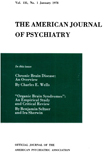THE HYPOTHESIS OF RECIPROCAL COMPLEMENTARITY
Abstract
If human functioning on the muscular, glandular, and mental levels characteristically involves circular causality rather than direct cause-effect and if, further, elements which separately function antagonistically combine reciprocally to complement each other in new functional nexuses, it seems reasonable to infer that a similar situation of circular causality and reciprocal complementarity exists between the individual and his moral codes. Since he has the power to assimilate concepts of morality in the cerebral cortex, and since the cortex is one of the factors which can initiate, facilitate, or inhibit his response, man is a positive and responsible agent rather than a passive puppet in the self-society nexus.
In a subsequent article I shall show how mental disorder, alcoholism, and other conditions (and their therapy) can be interpreted in terms of reciprocal complementarity. I hope to demonstrate that at least some of the seeming contradictions in such conditions which cannot be explained by conventional cause and effect nor in terms of antagonism between emotional drives and the social controls can be explained in terms of circular causality and complementarity between man and the social codes through which he functions.
Access content
To read the fulltext, please use one of the options below to sign in or purchase access.- Personal login
- Institutional Login
- Sign in via OpenAthens
- Register for access
-
Please login/register if you wish to pair your device and check access availability.
Not a subscriber?
PsychiatryOnline subscription options offer access to the DSM-5 library, books, journals, CME, and patient resources. This all-in-one virtual library provides psychiatrists and mental health professionals with key resources for diagnosis, treatment, research, and professional development.
Need more help? PsychiatryOnline Customer Service may be reached by emailing [email protected] or by calling 800-368-5777 (in the U.S.) or 703-907-7322 (outside the U.S.).



